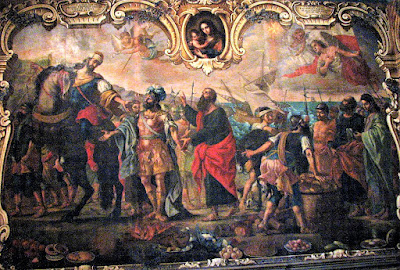Sibling rivalry is not often mentioned in the Gospels, but we know that John and his brother James were always trying to impress Jesus, while their mother spoke in their regard so that they get preferential treatment in heaven. Then there was Peter who had his brother Andrew close to him, both fishermen, but Jesus had the soft spot for Peter, while Andrew stayed in his shadow. Andrew became a disciple of the great St John the Baptist, but when John pointed to Jesus and said, "Behold the Lamb of God!" Andrew understood that Jesus was greater. At once he left John to follow the Divine Master. He was actually the first apostle Jesus called at the Sea of Galilee. At first the two brothers continued to carry on their fishing trade and family affairs, but later, the Lord called them to stay with Him all the time. He promised to make them fishers of men, and this time, they left their nets for good. It is believed that after Jesus ascended into Heaven, St Andrew went to Greece to preach the gospel, as well as along the Black Sea. He is said to have been put to death on a cross, to which he was tied, not nailed. He lived two days in that state of suffering, still preaching to the people who gathered around their beloved Apostle. Various countries have chosen St Andrew as their patron saint, among them Russia, Ukraine, Romania and Scotland. In fact, Scotland has incorporated his X-shaped cross in their flag, repeated again in the Union Jack, the British flag.
Relics of the Apostle Andrew are kept at the Basilica of St Andrew in Patras, Greece; the Duomo di Sant'Andrea, Amalfi, Italy; St Mary's Roman Catholic Cathedral, Edinburgh, Scotland; and the Church of St Andrew and St Albert, Warsaw, Poland. There are also numerous smaller reliquaries throughout the world. The two photos reproduced show the main painting of St. Andrew and inside the famous church San Andrea della Valle in the heart of Rome. The church is featured in the first act of the opera Tosca by Giacomo Puccini, where a solemn procession takes place.



.jpg)

































